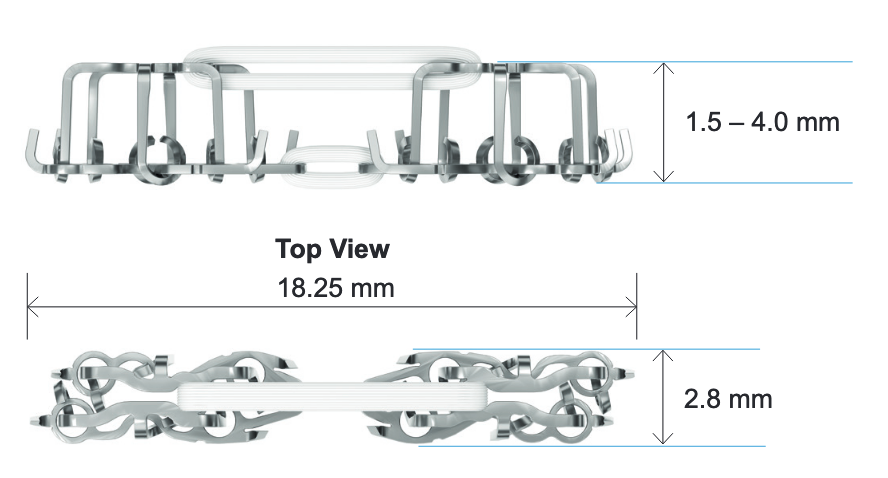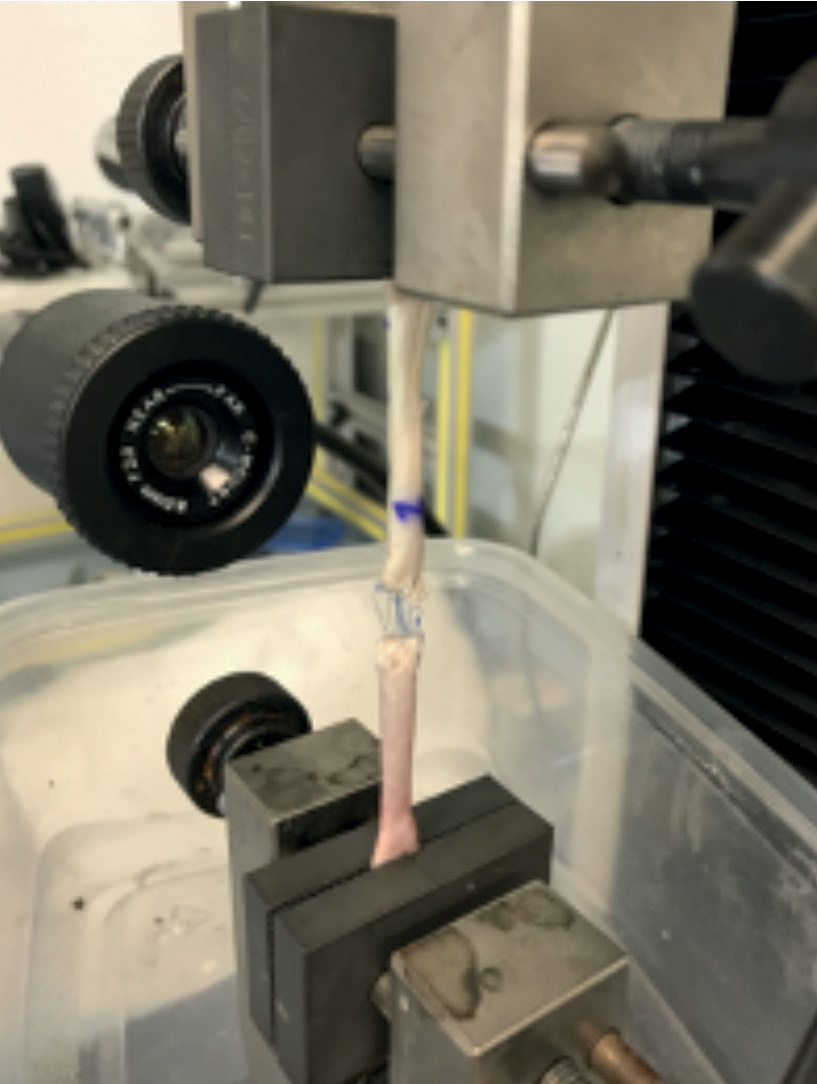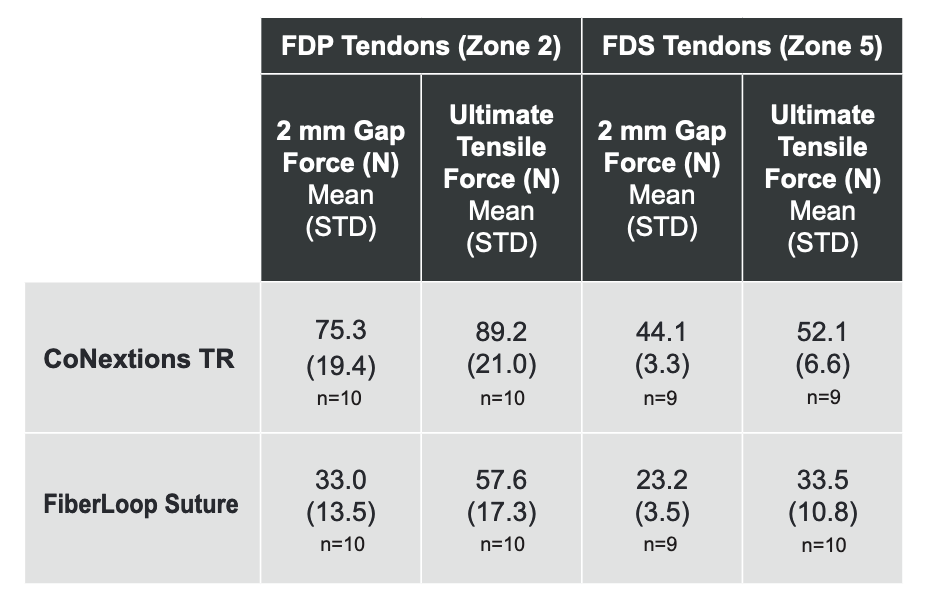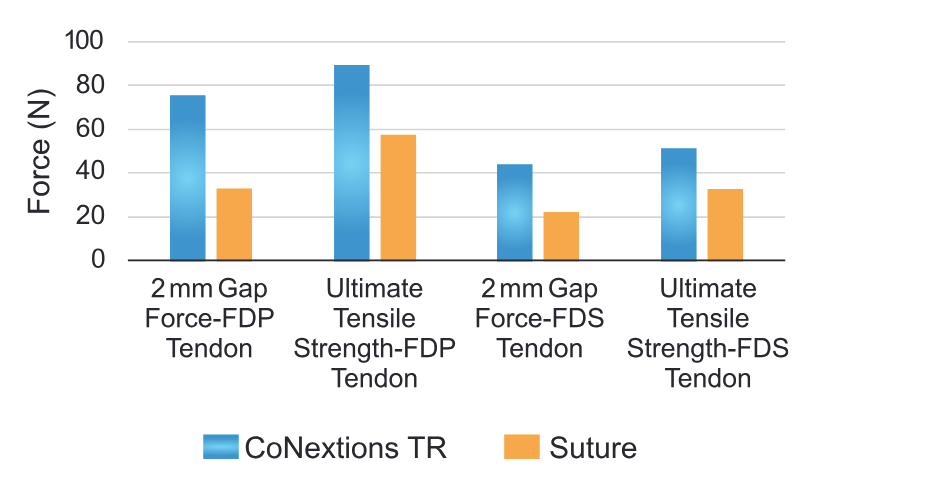CoNextions Research & Development
Strength Biomechanics White Paper
Objective
The purpose of this study was to compare the tensile strengths of repairs made to transected cadaveric digital flexor tendons with the CoNextions TR Tendon Repair System or a conventional suture repair technique.
Background
Suture has remained the standard of care for the repair of lacerated or severed tendons since it was first documented over 1800 years ago (Manske 2005). Despite advancements in biomaterials, operative techniques, and rehabilitation protocols, postoperative complications following tendon repair are still common. These complications include rupture of the tendon repair and adhesion formation at the repair site and can lead to long-term restriction of the joint mobility, additional surgical procedures, and extensive rehabilitation (Dy 2012). The CoNextions TR Tendon Repair System was designed to provide an alternative to suture for the repair of tendons. The implant consists of two identical stainless steel anchors implanted simultaneously into the injured tendon. The tendon repair site is centered between the anchors which are connected by two loops of ultra-high molecular weight polyethylene (UHMWPE) fiber (Figure 1).
The CoNextions TR implant is provided in two pieces preloaded into an Implant Mechanism. During implant deployment the top and bottom pieces of the implant form together securing the reapproximated ends of the injured tendon. The system was designed for the repair of tendons that are 1.5 to 4 mm in thickness and at least 3 mm in width. The system requires at least 20 mm (10 mm/side) of surgical site access for proper implant deployment.

Sample Preparation
Ten (10) flexor digitorum profundus (FDP) tendons at the digit level (Zone 2) and 10 flexor digitorum superficialis (FDS) tendons at the wrist level (Zone 5) from cadaveric specimens were measured and transected at two locations within the specified Zone. One transection was repaired using the CoNextions TR System with the other transection repaired using an 8-strand locked cruciate suture repair using 4-0 FiberLoop® Suture (AR-7249-20, Arthrex, Inc.). All repairs were performed by a fellowship-trained orthopedic hand surgeon.
Tensile Testing
Samples were excised from the cadaver following the repair procedures and pulled to failure at a rate of 20 mm/min on an Instron® tensile testing machine. (Instron 3342 Series Universal Testing Device, Instron Corporation). The load at 2 mm of displacement (2 mm Gap Force) and ultimate tensile strength were recorded for each sample (Figure 2).

Results
The failure mode for all test samples was pull- through at the device/soft tissue interface with the exception of one suture FDP repair that had a knot untie. CoNextions TR specimens produced higher 2 mm Gap Forces and Ultimate Tensile Strengths in Zone 2 FDP tendons and Zone 5 FDS tendons (Table 1, Figure 3).
Note: One FDS tendon in the CoNextions TR group was damaged during excision and tendon measurements were not recorded for one FDS tendon in the Suture group. These results were excluded.

Tukey’s Pairwise Comparisons showed 2 mm gap force values for the CoNextions TR group were significantly greater than those for the suture group for both sets of tendons (α=0.05).The ultimate force values for the CoNextions TR group were significantly greater than the suture group for the FDP tendons. For FDS tendons, the ultimate force values for the CoNextions TR group were directionally superior to the suture group, though this difference did not reach statistical significance (α=0.05).

Conclusion
Repairs produced using the CoNextions TR System had significantly higher 2 mm gap force and ultimate tensile force compared to a conventional suture repair technique for FDP tendons transected in Zone 2. For FDS tendons transected in Zone 5, the CoNextions TR System produced significantly higher 2 mm gap forces and directionally higher ultimate tensile forces than those seen with conventional suture repairs.
References
Dy CJ, et a. Complications after flexor tendon repair: a systematic review and meta analysis. J Hand Surg AM 2012;37A:543-51.
Griffin M, et al. An overview of the management of flexor tendon injuries. Open Orthopaedics Journal 2012;6:28-35.
Manske, P. History of flexor tendon repair. Hand Clin 2005;221(2):123-7
Other Reads:
CoNextions ASSH Abstract White Paper | CoNextions Zone 2 Glide White Paper | Clinical Trial Summary
This document is intended solely for the use of healthcare professionals. Benchtop testing may not be indicative of clinical performance. The information presented is intended to demonstrate a CoNextions Inc. product. CoNextions does not practice medicine and recommends that surgeons be trained in the use of any particular product before using it in surgery. A surgeon must always rely on his or her own professional clinical judgment when deciding whether to use a particular product when treating a particular patient. CoNextions does not dispense medical advice and recommends that surgeons be trained in the use of any particular product before using it in surgery. Individual results will vary based on health, weight, activity and other variables. Not all patients are candidates for this product and/or procedure. Products may not be available in all markets because product availability is subject to the regulatory and/or medical practices in individual markets. Please contact your CoNextions representative if you have questions about the availability of CoNextions products in your area. For indications, contraindications, warnings, precautions, potential adverse effects and patient counselling information, see the package insert or contact your local representative. Visit www.conextionsmed.com for additional product information. CoNextions owns, uses, or has applied for the following trademarks: CoNextions, Coronet, Revolutionizing Tendon Repair. Sawbones is a trademark of Pacific Laboratories Inc. FiberWire is a trademark of Arthrex, Inc. Instron is a trademark of Illinois Tool Works Inc.
MC0010.A
© 2021 CoNextions Inc. All Rights Reserved. U.S and Foreign Patents Pending. Patented in the U.S. Patent No. 10,219,804.
